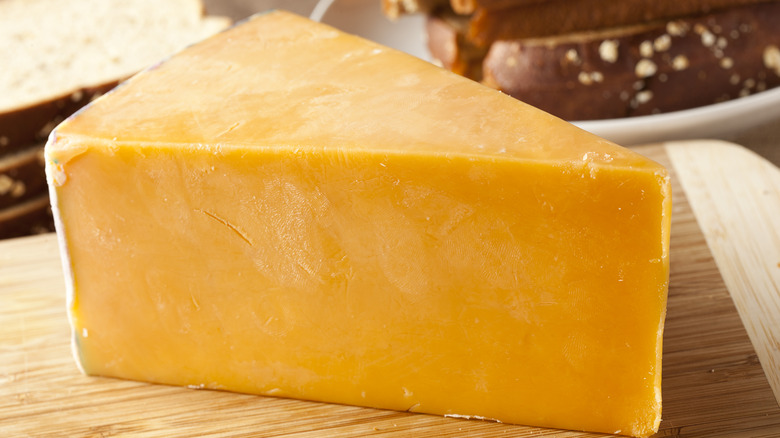The Fascinating History Behind Why Some Cheese Has That Bright Orange Color
Bold, bright, look-at-me colors in foods are usually the tip-off: The color came from somewhere else. Radioactive red? Food coloring. Screaming bright blue? Food coloring. Energetic yellow margarine? Coloring! Especially in that orangest of orange cheeses, American — it came from somewhere else. And let's not forget cheddar, which can be as orange as a marigold.
The way cheddar — or pretty much any cheese with bright orange or yellow tones — gets its color is no secret. Cheesemakers put it there on purpose. Without additives, cheese typically beckons in white or paler sunny shades.
Annatto, made from the seeds of achiote, or Bixa orellana (sometimes known as the lipstick tree) stars as the colorant in many fermented dairy products. Grown in tropical countries and popular in Latin American and Caribbean dishes, annatto is added to create a bright orange-yellow hue. Textiles and makeup use annatto, but so does food production, where the vibrant seeds are incorporated into desserts, sausages, sauces, drinks, and, of course, dairy. Butter? It uses annatto. Cheese? You bet — and the reason has everything to do with consumer psychology.
The connection between color and price
The amount of annatto color used in dairy is said to have little effect on flavor, so the reasons for its use tie into the psychology of consumer choice. That seemed plain even to cheesemakers hundreds of years ago, before any fancy marketing studies confirmed their intuitions. More than just influencing emotions, those valuable but intangible marketing tools, color can transform customer preference from negative to positive in cheese specifically. For cheesemakers, that's almost as good as money in the bank.
According to University of Vermont professor Paul Kindstet, English cheesemakers in the 17th century knew this. As such, the difference between white and orange cheddar became something that people imagined based entirely on looks. Prior to this time, the color of cheese correlated to cows' diets. While cheese from goat's milk is white due to its acidity (and the animal's digestive system), cheese made from cow's milk carries the beta-carotene from the grass the animals feed on, naturally coloring it. As such, seasonality was a major factor: In areas where grass was not as abundant throughout the year, the milk likely contained less yellow and orange tones. Meanwhile, cheese made using milk from the spring and summer had a more vivid tint thanks to lusher, sun-nourished grass. Buyers saw cheese made with pigmented milk as a sign of value and quality, and cheesemakers used this to their advantage.
A cheese by any other color
Cheesemakers inadvertently removed the color from their cheeses once they began skimming the cream off of the milk in order to make butter. Suddenly, the pigment-rich portion of what was to become an attention-grabbing hunk of delicious yellow cheese was gone. With color so closely tied to consumer choice, and with their cheese now low in fat, these artisans decided to take matters into their own hands. They dyed their cheese using a number of different methods to keep it aligned with buyer expectations and keep their prices up.
Early cheese dyes included foods like saffron and carrot juice. The tradition has continued, with annatto eventually becoming the most commonly used coloring. America's Test Kitchen points out that when it comes to cheddar, people from the country's eastern region prefer a white color, but yellow and orange hues become vastly more popular as you move toward the West Coast.
The next time you reach for your favorite fiery-toned sharp cheddar, imagine it in a more natural state and ask yourself if 17th-century cheesemongers were right all along.


